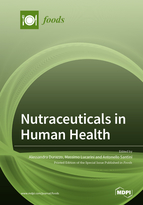Nutraceuticals in Human Health
A special issue of Foods (ISSN 2304-8158). This special issue belongs to the section "Nutraceuticals, Functional Foods, and Novel Foods".
Deadline for manuscript submissions: closed (31 December 2019) | Viewed by 88839
Special Issue Editors
Interests: bioactive compounds; natural products; nutraceuticals; antioxidants; dietary supplements; food quality; nutrition; food composition databases; bioavailability, metabolic pathway; nanoformulations
Special Issues, Collections and Topics in MDPI journals
Interests: natural compounds; nutraceuticals; natural products; food science and nutrition; food composition databases; bioaccesibility; dietary intake
Special Issues, Collections and Topics in MDPI journals
Interests: nutraceuticals; food chemistry; natural compounds; food supplements; food safety; medicinal chemistry; contaminants; secondary metabolites; functional food; biopolymers; nanomaterials
Special Issues, Collections and Topics in MDPI journals
Special Issue Information
Dear Colleagues,
Nutraceuticals are a challenge for the future of prevention and therapy. The possibility to prevent and/or support pharmacological therapy, which is nowadays mainly based on pharmaceuticals, can be a powerful tool to face pathological, chronic, long-term diseases in subjects who do not qualify for a pharmacological therapy.
Nutraceuticals are obtained from vegetal or animal origin foods, and prospective research on them will clarify their role, safety and efficacy by substantiating their role with clinical data. An effort to clarify their mechanism of action will open a door to a next generation of therapeutic agents that do not propose themselves as an alternative to drugs, but, instead, can be helpful to complement a pharmacological therapy, and to prevent the onset of chronical diseases.
The market as well as the interest of people in naturally-derived remedies and less synthetic pharmaceuticals is growing, and the attention of the collective imagination is nowadays more strongly focused on these food-derived products.
This Special Issue is dedicated to the role of and perspectives on nutraceuticals in human health, examined from different angles ranging from analytical aspects to clinical trials, from efficacy studies to beneficial effects on health conditions.
Dr. Alessandra Durazzo
Dr. Massimo Lucarini
Prof. Dr. Antonello Santini
Guest Editors
Manuscript Submission Information
Manuscripts should be submitted online at www.mdpi.com by registering and logging in to this website. Once you are registered, click here to go to the submission form. Manuscripts can be submitted until the deadline. All submissions that pass pre-check are peer-reviewed. Accepted papers will be published continuously in the journal (as soon as accepted) and will be listed together on the special issue website. Research articles, review articles as well as short communications are invited. For planned papers, a title and short abstract (about 100 words) can be sent to the Editorial Office for announcement on this website.
Submitted manuscripts should not have been published previously, nor be under consideration for publication elsewhere (except conference proceedings papers). All manuscripts are thoroughly refereed through a single-blind peer-review process. A guide for authors and other relevant information for submission of manuscripts is available on the Instructions for Authors page. Foods is an international peer-reviewed open access semimonthly journal published by MDPI.
Please visit the Instructions for Authors page before submitting a manuscript. The Article Processing Charge (APC) for publication in this open access journal is 2900 CHF (Swiss Francs). Submitted papers should be well formatted and use good English. Authors may use MDPI's English editing service prior to publication or during author revisions.
Keywords
- nutraceuticals
- medicinal food
- safety
- health
- regulation
- clinical tests
- efficacy
- analysis
- formulation









